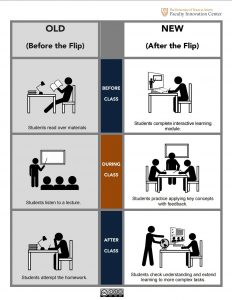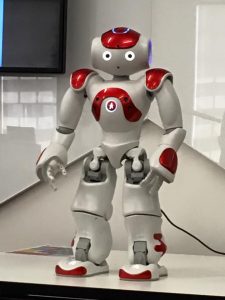
Photo by Jimmy Chang on Unsplash
Every university in the world is exploring fast effective ways to transform teaching. I think one good way forward is through the MASSIVE INTRODUCTION of VIDEO (MIV). Not just recording lectures but much much more!
Video is a key pathway towards ‘Education 3.0’, where learners are creators of knowledge and the boundaries of traditional educational structures are blurred.
Here I explore some of the ways we are introducing video for transforming our students’ experiences at the University of Western Australia (along with acquisition of a sparkling new Enterprise Video Management system, EVMS).
Example opportunities
| If you want to accomplish… | Recommended approach |
|---|---|
| Learners working through conceptual material at their own pace and then focusing face-to-face class time on interaction and application of concepts | Flipped classroom |
| Sparking creativity and build practical skills | Learners as creators |
| Providing effective, meaningful feedback to learners | Video feedback |
| Inspiring and engaging learning by incorporating multiple perspectives | ‘Authentic voices’: Digital storytelling |
| Supporting learners’ mastery of procedural or hands-on tasks | Demonstrations and simulations |
| Building motivation and connections with students | Welcome and ‘update’ videos |
(Bates, 2015; Deakin Learning Futures Teaching Development Team, 2014; Institute for Teaching and Learning Innovation, 2017)
1. Flipped classroom
A flipped approach means that ‘content delivery’ happens outside of the classroom, usually digitally and available for students to access in their own time and way. Students engage with videos, readings, e-tivities and other preparatory work provided digitally, e.g., in a learning management system (LMS). Then, instead of lectures, in-person class and group time is used to apply, explore or extend concepts, for example in workshops, labs, discussions, or hands-on activities. Hence flipped classrooms can improve engagement and active learning by substituting less engaging lecture-style delivery with interaction and applied learning. The classwork time is typically in a ‘sandwich’ – and students then follow up digitally, perhaps with assessment and feedback opportunities.

University of Texas at Austin, Faculty Innovation Center.
Attribution-NonCommercial-NoDerivatives 4.0 International
Video plays a significant role in a flipped approach, as it is often used to convey conceptual material that is more traditionally covered in lectures. Videos can be combined with readings and other preparatory materials provided digitally.
The flipped classroom approach allows students to learn at their own pace, as they can stop, backtrack, and review while watching videos. Motivation appears to increase when students know that they need to apply or discuss the out-of-class content during face-to-face class time (Bishop & Verleger, 2013).
Example:
Hessom Razavi and Sanjay Ramanathan (Medicine) are creating a digital learning program about ophthalmology for medical students. ‘Eyeballs made easy’ takes a flipped classroom approach to increase and enhance students’ eye care knowledge and practice, combining videos and e-learning with face-to-face teaching.
2. Learners as creators
One powerful way to incorporate video in learning and teaching is to have the learners create videos, either individually or as part of a group, perhaps instead of a written assignment or exam.
The opportunity to create videos allows learners to:
- Have rich learning experiences
- Experience independence and ownership over their creation
- Collaborate with each other
- Develop skills in digital storytelling (Kearney, 2011)
- Contribute creatively to society and discuss their creations
- Experience the challenge of communicating through the medium of film
- Develop skills in film-making, research, communication, and technology (Institute for Teaching and Learning Innovation, 2017)
- Promote critical reflection and development of a personal narrative (Reeves et al, 2017)
Example:
In this initiative at Loughborough and Sheffield Hallam universities (UK), learners undertook a video reporting project as an assessment in engineering and materials science units, allowing learners to gain knowledge and skills through research and video creation (Willmot, Bramhall, & Radley, 2012).
3. Video feedback
When providing video feedback, markers or unit coordinators can record themselves verbally commenting on assignments and then provide learners with the video file instead of, or in addition to, written feedback. Personalised feedback can be recorded for each student and/or the unit coordinator could record a general message addressing common strengths or weaknesses in the class.
Video provide students with better quality feedback and quantity of feedback, better comprehension of the feedback, and improve their rapport with learning leaders (Chalmers, et al, 2014; Knauf, 2015; Robinson et al, 2015; Turner & West, 2016).
Example:
Shannan Maisey and Dino Spagnoli (Chemistry) carried out an initiative (see the project blog) that provides students with instant feedback in the lab or classroom. Students prepare for lab sessions by reading and watching demonstration videos. In the lab, they demonstrate the required skills in front of the instructor, who uses a mobile device to rate the performance. This generates an email that provides students with videos that explain how they performed and give instructions on further skill development.
4. Authentic voices: Digital storytelling
Interviews with experts or community members can be used as primary sources of study and promote experiential learning. Recordings of public lectures or events can be repurposed and used for different contexts and subjects and present different perspectives. Live or recorded online discussions can demonstrate debate and decision-making in action.
As an experiential learning tool, these types of videos can:
- Facilitate authentic engagement with external people and their viewpoints
- Bring topics to life by demonstrating real scenarios
- Substitute for or enhance a field visit
- Present primary resources or case-study material
- Synthesise multiple events to show real world outcomes
- Demonstrate decision-making processes ‘in action’
- Help change student attitudes by presenting material from different and authentic perspectives. (Bates, 2015)
Unit co-ordinators can incorporate videos that already exist (as permitted by copyright) as well as create their own videos that tell stories and bring different perspectives to the learning experience.
Digital storytelling approaches are best connected with other learning activities, such as discussions, reflective writing, and critical analysis (Kearney, 2011). These can be classroom activities as well as activities carried out in the LMS and formal assessment items.
Annotation tools can be used to make learning with videos more interactive, as they allow students to comment or respond to questions at particular points in the video. These tools can be used to support active learning with videos and provide learners with feedback on their understanding.
Example:
An initiative called Legal Storytelling was introduced into the Juris Doctor (JD) program at the University of Western Australia in February 2017. A film of a hypothetical fact scenario is used as the basis of problem-solving, role-plays, case studies, and professional skills development throughout the degree.
5. Demonstrations and simulations
Videos can be used to demonstrate or simulate experiments and procedures. A video demonstration is often more effective, accessible and repeatable than text or static image representatives of complex procedures. They can include lab procedures, use of technical equipment, client interaction techniques, use of software, and so on. They can also include steps that students will need to follow later on their own, in a lab or in a work experience setting.
Videos can help students to master knowledge and procedures by allowing them to learn at their own pace and revisit the content repeatedly (Bates, 2015).
Simulations or demonstrations of software used on a computer can be recorded with screen capture software. Other types of demonstrations in a physical setting can be recorded with a video camera or mobile device.
Example:
Mary Gee (Earth and Environment) and her team are developing interactive videos to support students’ development of field skills in geology before, during, and after a fieldwork experience. Students take a different pathway through the videos depending on their answers to questions. The videos help students prepare for full engagement in the field as well as continue their skill development and complete the assessment afterward.
6. Welcome and ‘update’ videos
Welcome videos and more frequent informal update videos or podcasts can help learning leaders (lecturers) set the tone for learning for their units, easily and quickly highlight important issues, answer questions and alert learners to deadlines.
Welcome and update videos allow learning leaders to:
- Welcome and motivate learners
- Have a voice to connect personally with students outside of lecture settings
- Help learning leaders keep ‘in touch’ with their students
- Guide students with announcements, introductions to new topics, and key information
- ‘Humanise’ digital content
- The spark of a personal connection can really shape a learner’s experience (Dutton, 2017; Schmidt, 2017).
Example:
Gary Dufour’s (School of Design) short video welcomes and motivates students by previewing the material that will be studied in the unit, sparking their interest and engagement.
Make your Choice
So what do you think—are videos useful for higher education?
Would you like ideas that discuss using videos, such as this one, as a spark to start your dialogue?
Or perhaps you’d like to read 10 of the ‘top’ books first?
If you are/were Gen Z, which do you think you’d choose?
Further Reading
Bates, A. W. (2015). Teaching in a digital age: Guidelines for designing teaching and learning for a digital age. Retrieved from https://opentextbc.ca/teachinginadigitalage
Bishop, J. L., & Verleger, M. A. (2013). The flipped classroom: A survey of the research. In ASEE National Conference Proceedings, 30(9), 1-18. Retrieved from https://www.asee.org/public/conferences/20/papers/6219/view
Chalmers, C., MacCallum, J., Mowat, E., & Fulton, N. (2014). Audio feedback: richer language but no measurable impact on student performance. Practitioner Research in Higher Education, 8(1), 64-73. Retrieved from http://194.81.189.19/ojs/index.php/prhe/article/view/150
Deakin Learning Futures Teaching Development Team. (2014). Using audio and video for educational purposes. Retrieved from http://www.deakin.edu.au/__data/assets/pdf_file/0003/179013/Modules_1- 4_Using_audio_and_video_for_educational_purposes-2014-02-28.pdf
Dutton, A. (2017). Introduce yourself: Why professors should do video introductions. Kaltura blog. Retrieved from https://blog.kaltura.com/introduce-professors-video-introductions/
Forsey, M., Low, M., & Glance, D. (2013). Flipping the sociology classroom: Towards a practice of online pedagogy. Journal of Sociology, 49(4), 471-485. doi: 10.1177/1440783313504059
Hansch, A., Newman, C., Hillers, L., Shildhauer, T., McConachie, K., & Schmidt, P. (2015). Video and online learning: Critical reflections and findings from the field. Retrieved from http://papers.ssrn.com/sol3/papers.cfm?abstract_id=2577882
Institute for Teaching and Learning Innovation. (2017). Video for teaching and learning. Retrieved from http://www.uq.edu.au/teach/video-teach-learn/index.html
Kearney, M. (2011). A learning design for student-generated digital storytelling. Learning, Media and Technology, 36(2), 169–188. doi: 10.1080/17439884.2011.553623
Knauf, H. (2016). Reading, listening and feeling: audio feedback as a component of an inclusive learning culture at universities. Assessment & Evaluation in Higher Education, 41(3), 442-449. doi: 10.1080/02602938.2015.1021664
Ljubojevic, M., Vaskovic, V., Stankovic, S., & Vaskovic, J. (2014). Using supplementary video in multimedia instruction as a teaching tool to increase efficiency of learning and quality of experience. The International Review of Research in Open and Distributed Learning, 15(3). Retrieved from http://www.irrodl.org/index.php/irrodl/article/view/1825/2903
Reeves, T., Caglayan, E., & Torr, R. (2017). Don’t shoot! Understanding students’ experiences of video-based learning and assessment in the arts. Video Journal of Education and Pedagogy, 2(1), 1. doi: 10.1186/s40990-016-0011-2
Robinson, S., Centifanti, L., Brewer, G., & Holyoak, L. (2015). The benefits of delivering formative feedback via video-casts. UCLan Journal of Pedagogic Research, 6(1). Retrieved from http://pops.uclan.ac.uk/index.php/ujpr/article/view/326
Salmon, G. (2017). Higher education 1.0 to 3.0 and beyond. UWA Learning Futures blog. Retrieved from https://uwalearningfutures.edublogs.org/2017/03/22/higher-education-3-0/
Schmidt, N. (2017). Humanizing online teaching and learning: The quest for authenticity. EDUCAUSE Review Blog. Retrieved from http://er.educause.edu/blogs/2017/3/humanizing-online-teaching-and-learning-the-quest-for-authenticity
Skead, N. and Offer, K. (2016). Learning law through a lens: Using visual media to support student learning and skills development in law. Alternative Law Journal, 41(3), 186-190. Retrieved from http://search.informit.com.au/documentSummary;dn=406607143022037;res=IELAPA
West, J., & Turner, W. (2016). Enhancing the assessment experience: improving student perceptions, engagement and understanding using online video feedback. Innovations in Education and Teaching International, 53(4), 400-410. doi: 10.1080/14703297.2014.1003954
Willmot, P., Bramhall, M., Radley, K. (2012). Using digital video reporting to inspire and engage students. Retrieved from http://www.raeng.org.uk/education/hestem/heip/pdf/Using_digital_video_reporting.pdf
Woolfitt, Z. (2015). The effective use of video in higher education. Report for Inholland University of Applied Sciences. Retrieved from https://www.inholland.nl/media/10230/the-effective-use-of-video-in-higher-education-woolfitt-october-2015.pdf
Yousef, A. M. F., Chatti, M. A., & Schroeder, U. (2014). Video-based learning: A critical analysis of the research published in 2003-2013 and future visions. In eLmL 2014: The Sixth International Conference on Mobile, Hybrid and On-line Learning, 112–119. Retrieved from http://www.thinkmind.org/download.php?articleid=elml_2014_5_30_50050 Continue reading











